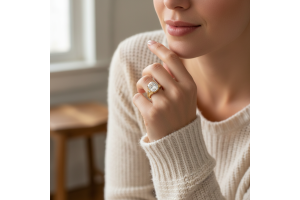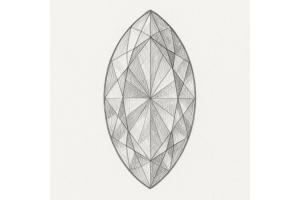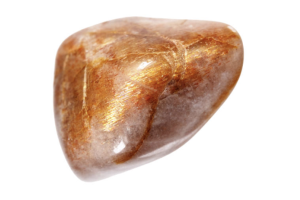USD
/
USD
/
Shipping to:
Currency:
Rubies have long been cherished for their deep, captivating red hues and remarkable durability.
As one of the most sought-after gemstones, they often command high prices, making them prime targets for imitation and synthetic alternatives.
Whether you're considering a purchase or simply curious about a ruby you already own, it's essential to know how to distinguish a genuine ruby from a fake.
This guide will walk you through various methods to help you identify a real ruby, from simple visual inspections to more advanced testing techniques.
Why Identifying a Real Ruby Matters
Determining whether a ruby is authentic is important for several reasons:
- Value Assessment: Natural rubies are significantly more valuable than synthetic or imitation versions.
- Investment Protection: Ensuring you're buying a genuine ruby protects your financial investment.
- Sentimental Value: Authentic rubies often carry personal or family significance, making their authenticity essential.
If you're shopping for alternatives, you might also want to check out our selection of gemstone engagement rings featuring ethically sourced natural gemstones.
What Is a Ruby?
Rubies are a variety of the mineral corundum, characterized by their red color, which comes from the presence of chromium.
While sapphires are also made of corundum, they include all other colors except red.
The most prized rubies display a deep, vivid red, often called "pigeon's blood" red.
For more details on gemstone formation and how rubies compare to diamonds, check out our guide on how and where gemstones and diamonds are formed.
Visual Inspection Techniques
Look at Color and Clarity
A real ruby typically has a rich, vibrant red hue.
However, natural rubies often contain inclusions—tiny internal flaws—that may affect clarity.
Be cautious of stones that appear too clear or have a perfect color, as they may be synthetic.
Keep in mind that some natural rubies can also be very clear, but these are rare and usually certified.
If you're unsure whether to go for natural or lab-created gemstones, check out our guide comparing lab-grown diamonds vs gemstones.
Check for Inclusions
Natural rubies usually contain small inclusions, such as tiny crystals or needle-like structures called "silk."
These inclusions form naturally and are often unique to each stone.
In contrast, synthetic rubies may contain gas bubbles or show curved growth lines, which are not found in natural rubies.
Test Hardness
Rubies rank 9 on the Mohs scale of hardness, making them extremely hard.
They can scratch most other materials but should not be scratched easily themselves.
However, scratch tests at home are not recommended, as they can damage the stone or its setting.
Advanced Testing Methods
Use a Loupe or Microscope
Looking at a ruby under magnification can reveal internal characteristics that indicate whether it's real.
Natural rubies may show inclusions like rutile needles, while synthetic ones might show curved striae or gas bubbles.
A jeweler's loupe or microscope can help you see these details.
If you're browsing other unique gemstone jewelry options, be sure to check out our collection of non-traditional engagement rings.
Try a UV Light Test
Both natural and synthetic rubies can fluoresce under ultraviolet (UV) light, usually glowing red or pink.
The intensity and appearance of the glow can vary.
Some synthetic rubies may glow more intensely than natural ones.
However, not all rubies fluoresce, and the absence of fluorescence doesn't automatically mean the stone is fake.
Heat Conductivity Test
Diamond testers measure heat conductivity, but they're not reliable for rubies.
Natural rubies and imitations can have similar thermal properties, so this method is inconclusive.
The Role of Professional Certification
For high-value rubies, it's best to get a certificate from a reputable gemological lab, such as the Gemological Institute of America (GIA) or the International Gemological Institute (IGI).
These certificates provide expert verification of a ruby's authenticity and quality.
Common Ruby Imitations
Red Spinel
Red spinels are often mistaken for rubies but have a different chemical makeup.
They also lack ruby's hardness and crystal structure.
Garnet
Red garnets can resemble rubies but usually have a deeper red with brownish tones.
They're also softer than rubies and have different refractive properties.
Glass Imitations
Some fake rubies are simply colored glass.
You can usually spot them by looking for bubbles inside the stone and testing their hardness.
If you're interested in classic alternatives, take a look at our elegant diamond wedding rings.
Tips for Buying a Real Ruby
- Buy from Trusted Sellers: Make sure the seller has a solid reputation and positive reviews.
- Ask for Certification: Always request a gemological certificate from a recognized lab.
- Be Wary of Deals That Seem Too Good: High-quality rubies are rare and expensive. If the price seems too low, it’s probably too good to be true.
- Consider Other Gemstone Options: If you're open to alternatives, explore our range of gemstone engagement rings for something unique and meaningful.
Frequently Asked Questions
Can I tell if a ruby is real just by looking at it?
While certain visual signs can offer clues, accurately determining a ruby's authenticity usually requires professional evaluation.
Natural and synthetic rubies can look very similar to the untrained eye.
Do all real rubies have inclusions?
Most natural rubies contain inclusions, but the absence of visible inclusions doesn’t necessarily mean the stone is synthetic.
Some high-quality natural rubies are very clear.
If a ruby glows under UV light, does that mean it's real?
Not necessarily.
Both natural and synthetic rubies can fluoresce under UV light.
The glow alone isn't enough to confirm authenticity.








